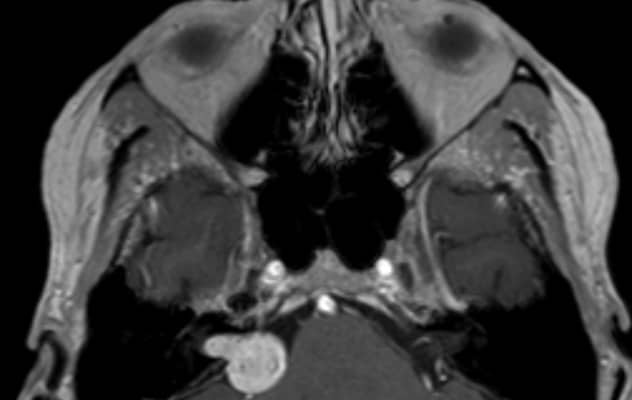July 21, 2021
Vestibular schwannomas are often considered rare, yet their prevalence is rising due to sensitive diagnostic imaging. The clinical behavior of these intracranial tumors is unpredictable, complicating decisions about optimal management. Mayo Clinic has a large-volume practice in vestibular schwannomas and multidisciplinary specialists with experience in all treatment options.
"Vestibular schwannomas have been the focus of our lateral skull base team for more than 20 years. We've dedicated our careers to treating these patients and have become national and international experts," says Michael J. Link, M.D., a neurosurgeon at Mayo Clinic in Rochester, Minnesota.
A neurosurgeon and an otolaryngologist meet jointly with each patient to assess the person's imaging, discuss treatment and achieve consensus on the best approach: observation, microsurgery or radiosurgery.
"All three treatments have merit, and we use them with relatively equal frequency. We don't have strong bias toward one particular treatment," says Matthew L. Carlson, M.D., an otolaryngologist at Mayo Clinic in Rochester, Minnesota.
In a review published in the April 8, 2021, edition of the New England Journal of Medicine, Drs. Carlson and Link noted the recent shift toward conservative management strategies that preserve hearing and quality of life for patients with sporadic vestibular schwannomas. Quality of life is a major focus of vestibular schwannoma research at Mayo Clinic.
"Data show that the diagnosis itself and various patient-related factors often affect quality of life more than treatment choice does," Dr. Carlson says. "Achieving the best quality of life means looking at all these patient-specific factors to provide the best treatment for each individual."
Expertise in all treatment approaches
Schwannoma vestibular

Schwannoma vestibular
La resonancia magnética axial ponderada en T1 con contraste de la cabeza muestra un tumor del ángulo pontocerebeloso en el lado derecho de tamaño medio que es consistente con un schwannoma vestibular.
Up to 25% of new vestibular schwannomas are identified incidentally during imaging that was obtained for unrelated indications. The tumors may be just millimeters in diameter. "Because MRI is now so widely available, vestibular schwannomas are often discovered when they're small and minimally symptomatic or asymptomatic," Dr. Link says.
Patients who are experiencing signs and symptoms might present with dizziness, imbalance, unilateral hearing loss or tinnitus. Large tumors can cause facial numbness or headaches due to hydrocephalus.
Mayo Clinic's multidisciplinary vestibular schwannoma team includes neurosurgeons and otolaryngologists as well as audiologists and physical therapists. Comprehensive vestibular evaluation is available.
"Our approach involves taking the time to meet as a team with patients and discuss the pros and cons of each treatment option for that individual," Dr. Link says. "We almost always recommend surgically removing large or very fast-growing tumors. But vestibular schwannomas are often growing slowly or not at all, so observation is an option for many patients with small or medium-sized tumors."
For patients who choose observation, Mayo Clinic recommends imaging and audiologic evaluation six months after the initial diagnosis. If the tumor isn't growing, imaging and hearing evaluations are performed annually for five years and possibly every two years after that. Lifelong follow-up is needed because vestibular schwannomas can undergo saltatory or delayed growth.
Some patients with smaller vestibular schwannomas prefer treatment over initial observation. "Just having a tumor in the head can create a lot of anxiety in some cases," Dr. Carlson says. "Preserving a patient's quality of life requires decision-making to center on the patient's goals and priorities."
When treatment is indicated, microsurgery is generally used to resect large vestibular schwannomas. The procedure requires the use of an operative microscope with intraoperative neural monitoring.
Although serviceable hearing is preserved after microsurgery in up to 70% of patients with small tumors, the rate is less than 5% after microsurgical removal of large tumors. Total resection of a large tumor also has a moderate risk of facial nerve paralysis. To avoid those complications, surgeons might leave a tumor remnant around the facial nerve and brainstem.
Radiosurgery is generally an option for tumors that measure less than 2.5 centimeters in diameter. Mayo Clinic's preferred mode of radiosurgery for treating vestibular schwannomas is Gamma Knife stereotactic radiosurgery. An early adopter of this technology, Mayo Clinic has performed Gamma Knife stereotactic radiosurgery for more than 30 years for more than 10,000 patients.
"We have a great deal of experience and expertise in radiosurgery, and in microsurgery and the wait-and-scan approach," Dr. Link says. "As a result, patient preference can play a major role in our decision-making."
For more information
Carlson ML, et al. Vestibular schwannomas. New England Journal of Medicine. 2021;384:1335.